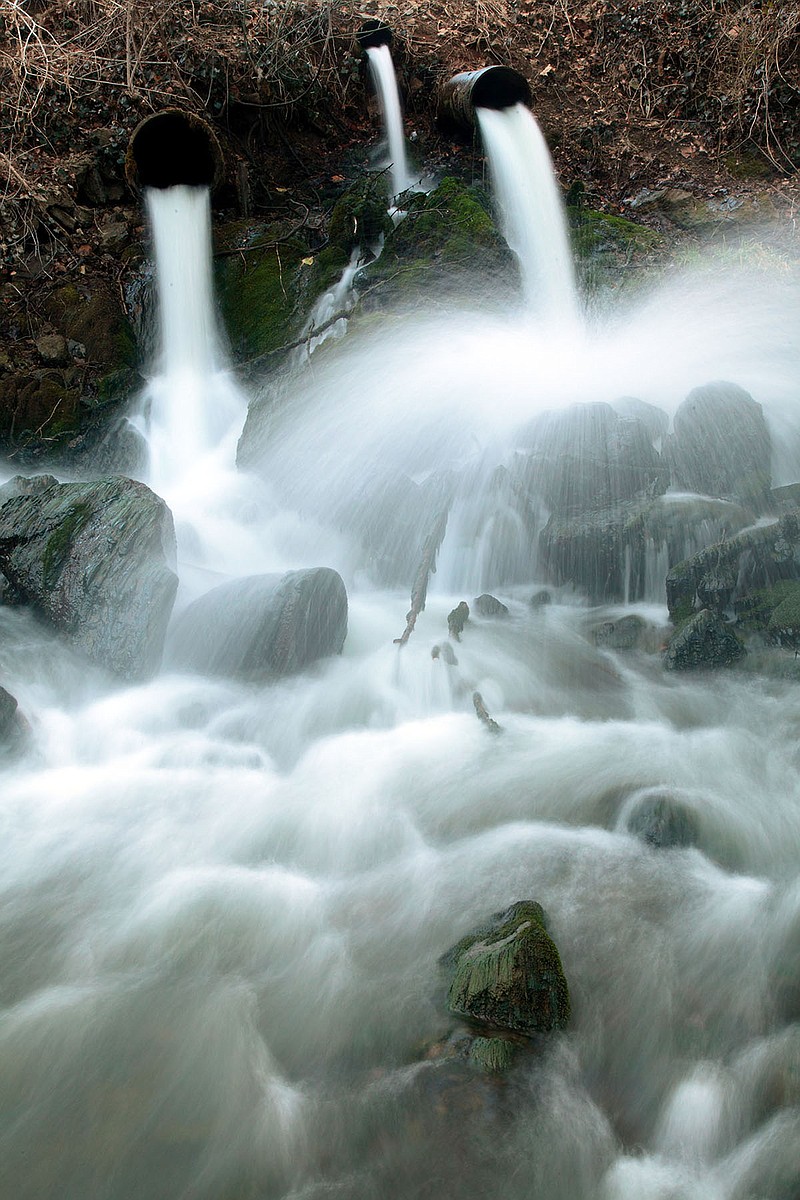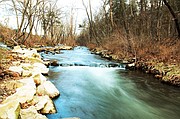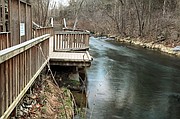Outdoor writer and photographer Corbet Deary is featured regularly in Thursday's edition. Today, Deary writes about Dry Run Creek.
While recently kicking around in the Ozarks, I happened across a small creek feeding into the Norfork River. There's nothing uncommon about small creeks feeding into our larger rivers. This little tributary, however, is much different. It has been designated to provide young anglers and disabled fishing enthusiasts with opportunities to experience the excitement of fishing for, and catching, trophy-class trout.
The project began a thought in 1989 and came to fruition in 1990. Since its completion, the facility has provided the young and disabled with excellent fishing ever since.
Located alongside Norfork National Fish Hatchery in north central Arkansas, this small creek benefits from fertile and oxygenated waters flowing in it from the facility. As one might suspect, these conditions provide an optimal habitat for trout to thrive.
Since it is a very short distance to from the Norfork Tailwaters, there is no shortage of fish. Although one is apt to catch trout in this stretch of water throughout all seasons, there are certain times when fishing on Dry Run Creek is phenomenal.
Every year, in late September and October, the trout, seeking oxygen-rich water, begin to move up the Norfork River en route to Dry Run Creek. They congregate in this small waterway and in the upper extremities of the river.
The trout remain in Dry Run Creek until finally heading back into Norfork and farther downstream to where it converges with the White River in late December and into January, where they will go about their annual spawn. By February, the spawn is over and they focus on feeding.
During my recent visit, it was a cold and windy early March day. Due to the fact it was mid week, there were no youngsters taking advantage of the facility. And I suspect the conditions were enough to persuade disabled folks to wait for a more tolerable day.
Although I would have savored the opportunity to burn some exposures of people catching trophy-class trout, I was also enthused to be able to kick around without concern of getting in the way of anglers and possibly spooking their potential catches.
Upon pulling into the parking area, I donned my cold weather gear, secured my camera bag and a tripod and walked a few feet to the path leading toward the water.
It didn't take long to figure out that a lot of thought had been put into the layout of the trail system. A beautifully built deck ran alongside the creek. Small fishing piers were spaced out along the wooden walkway, lending ample opportunity for folks in wheelchairs and others who aren't physically capable of scaling down the slope to experience an action-packed outing.
While walking along the walkway, I took in a beautiful perspective of the stream running just below. I was somewhat amazed that such a small creek was capable of coughing up trophy-class fish. No more than 20 feet wide in places and not likely exceeding 2 or 3 feet in depth, it appeared on the surface no different from the small mountain-fed streams around here that hold at best a few small panfish.
But looking into the water, I was quickly reminded that this destination doesn't fall into the same category as do our streams. I could actually see fairly impressive trout lurking in the crystal-clear waters.
I lack the skills to identify trout species while they swim beneath the surface. Some were small and could have been any of the four species native to the Norfork and White Rivers. I suspect, however, the larger fish I was seeing were either browns or rainbows.
After spending a little time and taking a few photos from atop the boardwalk-fishing pier, I skedaddled down the stairs to the water's edge and eased upstream.
The view from the structure was impressive, but the scene was equally as nice from the water's edge, if not more so. The rapids separating the crystal-clear pools cut their way through large boulders and over submerged rock formations. The base of each set of shoals provided a great environment for trout to wait for their next potential meal to unsuspectingly swim within striking range.
Easing farther upstream, I noticed a large outflow of water rushing from the hillside. Stepping across large boulders that had strategically been paced across a narrow drainage area, the source of the water became apparent. This was one of the locations where oxygenated water rushed from the hatchery. Although a product of man's ingenuity, it was an incredible and somewhat natural-looking scene.
Water spewed from a couple of large pipes and onto a steep slope carpeted with huge boulders. Running over and through the structures, it produced a fairly large waterfall. While admiring this structure, I pondered how it was beneficial in two ways. Not only did the water spectacle provide visitors with a nice scene, but it was partially responsible for the optimal habitat for trout to thrive.
Continuing farther up the creek, I happened upon yet another outlet from the hatchery. Again, water rushing over natural rocks and down a steep slope lent to a scene definitely worthy of snapping a few exposures. From this point down, the creek obviously provided the needed habitat for trout to thrive, but just upstream from this outlet it narrowed a great deal, transforming into a very small branch.
While easing back to the vehicle, I couldn't help but ponder how, although small in stature, Dry Run Creek was a very important destination, and a labor that benefited many.
It was a perfect location where youngsters could experience an exciting outing. But, most importantly, they might bond with mother nature, beginning a relationship that would hopefully last a lifetime. I also considered the importance of providing the disabled with a destination where they could also experience the sport of fishing at its finest.
To ensure that Dry Run Creek remains bountiful, many special regulations have been posted on this short and spectacular section of water. Only barbless hooks and artificial baits are allowed. All fish caught in this designated area are required to be released immediately. Only youth 16 years of age or younger and the mobility impaired are allowed to fish in these waters, and all youngsters must be accompanied by an adult. The facility is open to fishing from sunrise to sunset year-round.
I suppose some folks find it of utmost importance to wet a hook while near the water. However, those who take a kid or a friend or family member who is mobility impaired are likely to experience one of their most memorable and enjoyable days of fishing without a single cast.
To get to Dry Run Creek, from Mountain Home, take Highway 5 south for 14 miles to Salesville and turn left on Highway 177. Travel 2 miles, and the trailhead will be located on the left at the fish hatchery parking area.
Local on 04/17/2014


